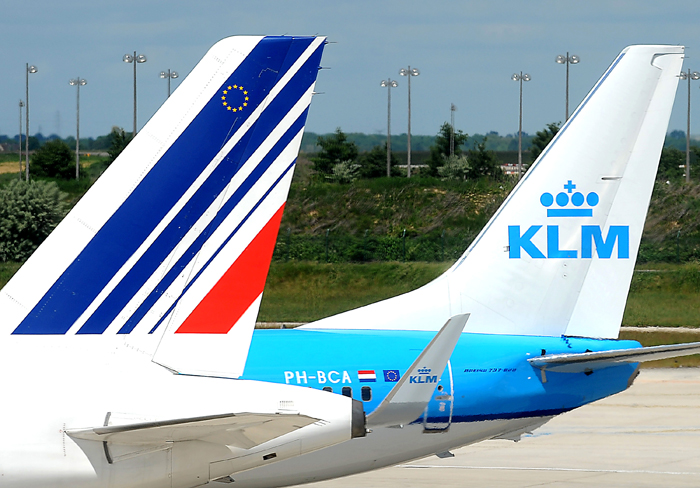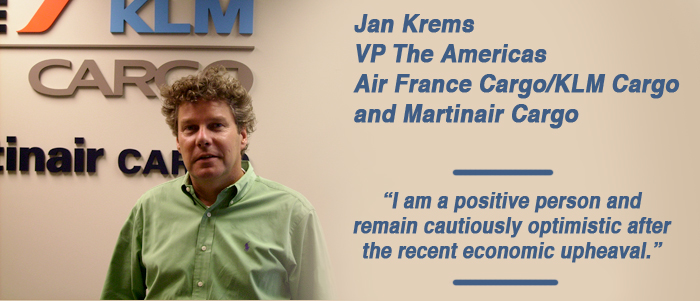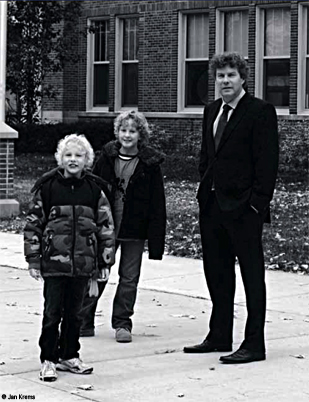

How do you successfully
blend these mentalities: KLM customer focus, Air France processes
and Martinair flexibility? Jan Krems, Vice President the Americas
thinks he has the answer – integration, and clearly rejoicing
in it. It is easy to underestimate the magnitude and scope of these
efforts or what it takes to manage this air cargo business worth $800
million per annum, half of it derived from the biggest market, the
U.S., but which spans six markets.
They six markets vary not only in size
but in product mix, growth potential and how each in turn is served.
It’s a fascinatingly complex weave, stage managed from the Americas
head offices in Atlanta by a mix of nationalities with Jan Krems at
the top, a driven dynamo who believes “we know what we are doing”
in face of the fact that every day is a new experience which presents
challenges to the team.
 |
The structure that has
been implemented consists of six regions each headed by a regional
director – the U.S., headed by Alain Pagés in Atlanta,
the Southern “cone” managed by Pier Luigi Vigada in Buenos
Aires that includes Argentina, Brazil, Chile, Paraguay and Uruguay,
Canada headed by Lori Burrell in Toronto, Central America & Caribbean
with Patricia Paulhiac in Panama also including Puerto Rico and Venezuela,
the Andean countries managed by Eric Maurox serving the Ecuador and
Colombia flower market with 6-7 freighter aircraft per week and last
but not least, Mexico with Maria Arana in charge.
The distance has been shortened significantly
not only by means of modern communications tools but also with having
a revenue manager in the Atlanta head office corresponding with the
regions. This may sound like an overly complex matrix organization
but it controls a varied cargo and aircraft mix with 55% lower deck
and 45% main deck and B747 and B777 aircraft in addition to passenger
aircraft and the 16-17 KL combis and MP MD11.
Jan Krems firmly believes that this
organization is well positioned to match and provide the best solution
to each market and respective customers based on the strength and
experience the three merged carriers bring to the table.
It is the constant task of adjusting,
tweaking and fine-tuning – one example are the 25 freighters,
which were in the air in 2009, versus the 15 currently operating.
To make the Rubik’s cube more complicated, there are also the
physical aircraft compatibility issues, certainly not unique to this
airline, yet having to account for the differences in contour when
trans-loading and load planning, given the B777 requirement for compressible
cargo in the front of the cabin, which doesn’t affect the B747.
This cornucopia of offerings is paralleled
by an equally diverse set of business tools – 35% of the customers
are served as contract customers, another 35% are over the counter
and the remaining 35% are ad hoc shipments. Size and lift combined
with market and customer specific solutions have its privileges. Contracts
by definition are long-term, often flight-specific and can be product-based
to fit in the lower deck or the main deck.
Experimenting is an everyday event in
everything – take the office layout, with all the offices along
the windowed side of the building having been refitted with glass
partitions instead of the regular drywall to allow natural light to
spill throughout the office. And if one thinks egalitarian, well,
we are shown a storage area lined with filing cabinets on wheels labeled
with their owner’s name, which belong to team members away from
the office. You guessed it, there are no permanent “this is
my office,” you get what is free on the day. Some love it, others
less so.
There is just the quiet hum of computers,
monitors and some phone conversations with the obligatory five clocks
for the time zones mounted prominently in the center of the room.
And you can just feel the throbbing pulse of this addictive airline
cargo business.
 Jan and his family started their global
journey some years ago in Singapore where his boys, now 13 and 11,
were born, moving back to the Netherlands, then Paris and eventually
hitting American shores in Chicago, where they spent four years before
landing in Atlanta a year ago. He travels about two weeks every month
throughout his area of responsibility.
Jan and his family started their global
journey some years ago in Singapore where his boys, now 13 and 11,
were born, moving back to the Netherlands, then Paris and eventually
hitting American shores in Chicago, where they spent four years before
landing in Atlanta a year ago. He travels about two weeks every month
throughout his area of responsibility.
We asked Jan what surprised him the
most since assuming this position?
He responds that he has been surprised
but gratified by the flexibility of his people to make it work, their
willingness to relocate, adapt and move into new areas of the world.
As for his outlook on 2012, Jan says,
“I am a positive person and remain cautiously optimistic after
the recent economic upheaval.”
“I try to maintain a balance in
my life. I am into sports, golf and paddle, or platform tennis, which
I enjoy very much. I was invited to play in the nationals in Chicago
this year but unfortunately couldn’t make it. There are several
former professional tennis players who have taken up this sport. I
am interested in and follow all sports.
"Weekends are dedicated to the
family and I spend as much time as possible with my boys. We also
like to eat out, preferably Indian and Japanese food; the Atlanta
establishments have turned out to be a pleasant surprise."
Ted Braun
|

 Jan and his family started their global
journey some years ago in Singapore where his boys, now 13 and 11,
were born, moving back to the Netherlands, then Paris and eventually
hitting American shores in Chicago, where they spent four years before
landing in Atlanta a year ago. He travels about two weeks every month
throughout his area of responsibility.
Jan and his family started their global
journey some years ago in Singapore where his boys, now 13 and 11,
were born, moving back to the Netherlands, then Paris and eventually
hitting American shores in Chicago, where they spent four years before
landing in Atlanta a year ago. He travels about two weeks every month
throughout his area of responsibility.